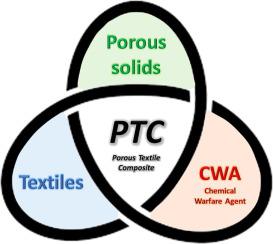Coordination Chemistry Reviews ( IF 20.3 ) Pub Date : 2022-05-17 , DOI: 10.1016/j.ccr.2022.214598 Nelly Couzon , Jérémy Dhainaut , Christine Campagne , Sébastien Royer , Thierry Loiseau , Christophe Volkringer

|
Since the first use of a chemical warfare agent (CWA), specific methods of protection have been developed to protect human body from such lethal compounds. The first protection systems rely on impermeable clothing or the capture of the toxics species by an adsorbent such as activated carbon. However, both present important limitations, i.e. heat stress for impermeable protection and a risk of saturation or release of toxic compounds for the adsorbent. The optimal protection should therefore be active, i.e. be able to both capture and detoxify CWAs. In this optic, this review describes active porous textiles composites (PTC) used as protective garments against CWAs. To this day, a large variety of porous compounds such as zeolites, metal organic frameworks (MOFs) or aerogels have shown catalytic degradation of CWAs. The integration of these active solids to textile fibers is then detailed, highlighting the importance of the electrospinning technique or the pre-functionalization of fibers. Concerning the detoxification process, MOFs have focused a large part of the PTC research due to their exceptional properties (high surface area and tunable porosity combined to a catalytic activity). More particularly, Zr-based MOFs exhibit exceptional results in terms of CWA detoxification and are currently highly studied. Besides, this present state of art includes other active PTCs (functionalized activated carbon fibers ACFs or zeolite composites) rarely discussed in reviews, to give a full overview of the existing PTC used against CWA.
中文翻译:

用于去除和分解化学战剂 (CWA) 的多孔纺织复合材料 (PTC) – 综述
自从首次使用化学战剂 (CWA) 以来,已经开发出特定的保护方法来保护人体免受此类致命化合物的侵害。第一种保护系统依赖于不透水的衣服或通过活性炭等吸附剂捕获有毒物质。然而,两者都存在重要的限制,即不渗透保护的热应力和吸附剂饱和或释放有毒化合物的风险。因此,最佳保护应该是主动的,即能够捕获和解毒 CWA。在这个光学中,这篇综述描述了用作对抗 CWA 的防护服的活性多孔纺织品复合材料 (PTC)。迄今为止,大量的多孔化合物,如沸石、金属有机骨架 (MOF) 或气凝胶已显示出 CWA 的催化降解作用。然后详细介绍了这些活性固体与纺织纤维的结合,强调了静电纺丝技术或纤维预功能化的重要性。关于解毒过程,MOF 因其卓越的性能(高表面积和可调节的孔隙率与催化活性相结合)而集中在 PTC 研究的很大一部分。更具体地说,基于 Zr 的 MOF 在 CWA 解毒方面表现出非凡的结果,目前正在得到高度研究。此外,目前的技术水平包括评论中很少讨论的其他活性 PTC(功能化活性碳纤维 ACF 或沸石复合材料),以全面概述用于对抗 CWA 的现有 PTC。强调静电纺丝技术或纤维预功能化的重要性。关于解毒过程,MOF 因其卓越的性能(高表面积和可调节的孔隙率与催化活性相结合)而集中在 PTC 研究的很大一部分。更具体地说,基于 Zr 的 MOF 在 CWA 解毒方面表现出非凡的结果,目前正在得到高度研究。此外,目前的技术水平包括评论中很少讨论的其他活性 PTC(功能化活性碳纤维 ACF 或沸石复合材料),以全面概述用于对抗 CWA 的现有 PTC。强调静电纺丝技术或纤维预功能化的重要性。关于解毒过程,MOF 因其卓越的性能(高表面积和可调节的孔隙率与催化活性相结合)而集中在 PTC 研究的很大一部分。更具体地说,基于 Zr 的 MOF 在 CWA 解毒方面表现出非凡的结果,目前正在得到高度研究。此外,目前的技术水平包括评论中很少讨论的其他活性 PTC(功能化活性碳纤维 ACF 或沸石复合材料),以全面概述用于对抗 CWA 的现有 PTC。更具体地说,基于 Zr 的 MOF 在 CWA 解毒方面表现出非凡的结果,目前正在得到高度研究。此外,目前的技术水平包括评论中很少讨论的其他活性 PTC(功能化活性碳纤维 ACF 或沸石复合材料),以全面概述用于对抗 CWA 的现有 PTC。更具体地说,基于 Zr 的 MOF 在 CWA 解毒方面表现出非凡的结果,目前正在得到高度研究。此外,目前的技术水平包括评论中很少讨论的其他活性 PTC(功能化活性碳纤维 ACF 或沸石复合材料),以全面概述用于对抗 CWA 的现有 PTC。











































 京公网安备 11010802027423号
京公网安备 11010802027423号